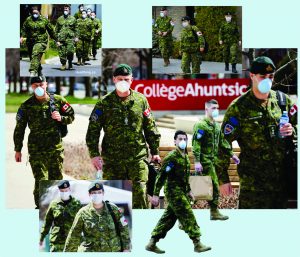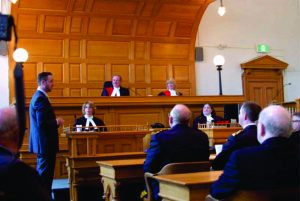Canada’s nursing home crisis:
The Majority (more than 80 percent) of Covid-19 deaths are in long-term care facilities. Almost one in ten nursing homes across the country reports Covid-19 cases
 Although the pandemic shows encouraging signs that the spread is slowing down in many parts of the country, nevertheless its relentless grip on long term care facilities continues unabated. This has prompted calls for both public inquiries, but also the deployment of military troops to some of the worst-affected LTCs in Ontario and Quebec, and a tacit admission from Prime Minister Trudeau that Canada is ‘failing’ its elderly. “We should not have soldiers taking care of seniors”, he said last month, “in the weeks and months to come, we will all have to ask tough questions about how it came to this”.
Although the pandemic shows encouraging signs that the spread is slowing down in many parts of the country, nevertheless its relentless grip on long term care facilities continues unabated. This has prompted calls for both public inquiries, but also the deployment of military troops to some of the worst-affected LTCs in Ontario and Quebec, and a tacit admission from Prime Minister Trudeau that Canada is ‘failing’ its elderly. “We should not have soldiers taking care of seniors”, he said last month, “in the weeks and months to come, we will all have to ask tough questions about how it came to this”.
Sharleen Stewart, president of Service Employees International Union Healthcare, which represents 60,000 health workers opined “the crisis was already here”.
Several factors — a frail and elderly resident population, old buildings with little space for separating the sick from the healthy, cramped living quarters, and frequent contact between residents and caregivers — make long-term care facilities petri dishes.
That was clear in early March, when Canada’s first outbreak and death occurred at North Vancouver’s Lynn Valley Care Center, grimly portending the tragedy that was yet to come.
But officials were more centred on outfitting hospitals —scrambling to stock ventilators and critical-care beds. Nathan Stall, a geriatrician at Toronto’s Sinai Health System, said long-term care was mostly overlooked.
“It wasn’t inevitable that this had to happen, and that’s the most troubling thing,” Stall said. “The decision-makers’ fear was driven by young people on ventilators in New York City, and it didn’t move the societal needle that people were dying in nursing homes elsewhere or even in our own country.”
Analysts say the sector has been chronically understaffed. Many employees, including health aides, are paid low wages and earn a living by working part-time shifts at several facilities without sick pay, making them possible vectors of transmission between homes.
“We’ve actually created a system that’s designed to fail,” said Samir Sinha, head of geriatrics at Toronto’s Sinai Health System and the University Health Network.
In Ontario, public health officials, faced with limited testing kits, initially advised against testing all long-term care residents. They also said health aides needed personal protective equipment only if their facilities had outbreaks. This left many in danger, given asymptomatic spread and the fact elderly people often present with atypical symptoms.
It was not until mid-April that the province banned staff from working at multiple facilities, required everyone to wear a mask, recommended widespread testing, and topped up workers’ pay. Closing the barn door after the horse has bolted! By then, many residents had died and many workers were ill, exacerbating staffing shortages. Soldiers, librarians, school board staff members and hospital workers had to be enlisted to fill those gaps.
Armed forces inside Long-term-care-homes. Troops could be called upon to testify.
 Members of the Canadian Armed Forces working inside long-term care homes could find themselves testifying about the state of those facilities in relation to lawsuits against the institutions.
Members of the Canadian Armed Forces working inside long-term care homes could find themselves testifying about the state of those facilities in relation to lawsuits against the institutions.
Damning military reports later said the troops found cases of abuse and negligence in the homes, including bug infestations, aggressive feeding of residents that caused choking, bleeding infections and residents left crying for help for hours.
Stephen Birman and Lucy Jackson of Toronto law firm Thomson Rogers are leading a proposed $20-million class-action lawsuit brought against a Scarborough, ON LTC on behalf of the home’s residents and their families.
The lawsuit against the LTC and its parent company, alleges negligence and breach of duty over a lack of proper protocols and training as well as severe understaffing and the lack of proper equipment before and during the pandemic.
It is one of several court actions brought against long-term care facilities since COVID-19 first hit in earnest in March, ravaging many homes across the country. Nursing home residents and staff account for the vast majority of COVID-19 deaths in Canada.
 Birman and Jackson say the troops’ firsthand observations could be critical in proving their clients’ claims against the home, particularly as lockdowns imposed since March have made it difficult to impossible for residents’ families to get into the facility.
Birman and Jackson say the troops’ firsthand observations could be critical in proving their clients’ claims against the home, particularly as lockdowns imposed since March have made it difficult to impossible for residents’ families to get into the facility.
Reports said the troops found cases of abuse and negligence in the homes, including bug infestations, bleeding infections and residents left crying for help for hours.
The unusual scenario follows the deployment of hundreds of service members in April and May to more than two-dozen nursing homes in Ontario and Quebec hit hard by COVID-19.
Another affront to seniors:
In a recent Toronto Sun opinion piece, Marissa Lennox chief policy officer at CARP stated: “Aggressiveness when changing incontinence pads, not slowing or stopping when resident complained of pain … Forceful feeding by staff causing audible choking/aspiration. Patients observed crying for help with staff not responding (for 20 minutes to two hours) … Cockroaches and flies present. Rotten food smell. Patients being left in soiled diapers rather than being ambulated to toilets.”
These are just some of the abhorrent observations made by the Canadian military over the past month in Ontario long-term care facilities.
Their unbiased findings have laid bare a system that is failing some of the most vulnerable members of society: Our elderly.
The findings have exposed the shameful treatment that thousands of seniors have suffered — and continue to suffer — in long-term care homes across the province.
In the wake of this report, and of thousands of deaths in long-term care facilities due to COVID-19, seniors and their loved ones are launching class-action lawsuits in pursuit of justice.
According to Ms. Lennox, among these is a $40-million lawsuit against an Ontario home, where of 308 residents, 225 contracted COVID-19, and 77 died.
Families are seeking compensation for the loss and suffering inflicted on them.
- They want change.
- They want justice.
But these grieving families may never get their day in court.
Bill 161, the Smarter and Stronger Justice Act, 2020, is an omnibus justice reform bill that, among many other things, proposes major reforms to Ontario’s Class Proceedings Act.
These changes fundamentally alter the test for the certification of class proceedings in favour of defendants — such as long-term care providers.
They would make it much harder for plaintiffs to certify a class action.
As a result, plaintiffs would have to sue individually — an extremely costly and difficult proposition, which most would not be able to undertake.
It could mean that residents suffering different forms of abuse — being force-fed to the point of choking, developing bedsores as a result of neglect, not receiving baths or personal care — might be denied the ability to form a class, despite the fact that their injuries stem from the same cause: rampant neglect of our elderly.
